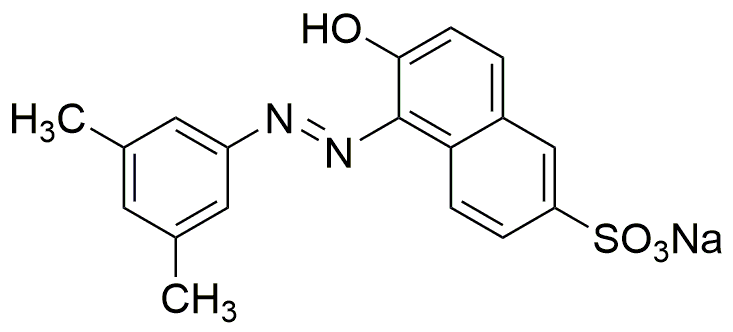Acid orange 17 is widely utilized in research focused on:
- Dyeing Textiles: This chemical is commonly used in the textile industry for dyeing fabrics, providing vibrant colors and excellent colorfastness.
- Food Coloring: It serves as a food dye, adding appealing color to various food products while adhering to safety regulations for consumption.
- Biological Staining: In laboratories, it is employed as a staining agent in microscopy, helping to visualize cellular structures in biological samples.
- Cosmetic Applications: Acid orange 17 is also found in cosmetic formulations, enhancing the visual appeal of products like lipsticks and creams.
- Research and Development: Researchers utilize this compound in studies related to dye-sensitized solar cells, exploring its potential in renewable energy applications.
General Information
Properties
Safety and Regulations
Applications
Acid orange 17 is widely utilized in research focused on:
- Dyeing Textiles: This chemical is commonly used in the textile industry for dyeing fabrics, providing vibrant colors and excellent colorfastness.
- Food Coloring: It serves as a food dye, adding appealing color to various food products while adhering to safety regulations for consumption.
- Biological Staining: In laboratories, it is employed as a staining agent in microscopy, helping to visualize cellular structures in biological samples.
- Cosmetic Applications: Acid orange 17 is also found in cosmetic formulations, enhancing the visual appeal of products like lipsticks and creams.
- Research and Development: Researchers utilize this compound in studies related to dye-sensitized solar cells, exploring its potential in renewable energy applications.
Documents
Safety Data Sheets (SDS)
The SDS provides comprehensive safety information on handling, storage, and disposal of the product.
Product Specification (PS)
The PS provides a comprehensive breakdown of the product’s properties, including chemical composition, physical state, purity, and storage requirements. It also details acceptable quality ranges and the product's intended applications.
Certificates of Analysis (COA)
Search for Certificates of Analysis (COA) by entering the products Lot Number. Lot and Batch Numbers can be found on a product’s label following the words ‘Lot’ or ‘Batch’.
*Catalog Number
*Lot Number
Certificates Of Origin (COO)
This COO confirms the country where the product was manufactured, and also details the materials and components used in it and whether it is derived from natural, synthetic, or other specific sources. This certificate may be required for customs, trade, and regulatory compliance.
*Catalog Number
*Lot Number
Safety Data Sheets (SDS)
The SDS provides comprehensive safety information on handling, storage, and disposal of the product.
DownloadProduct Specification (PS)
The PS provides a comprehensive breakdown of the product’s properties, including chemical composition, physical state, purity, and storage requirements. It also details acceptable quality ranges and the product's intended applications.
DownloadCertificates of Analysis (COA)
Search for Certificates of Analysis (COA) by entering the products Lot Number. Lot and Batch Numbers can be found on a product’s label following the words ‘Lot’ or ‘Batch’.
*Catalog Number
*Lot Number
Certificates Of Origin (COO)
This COO confirms the country where the product was manufactured, and also details the materials and components used in it and whether it is derived from natural, synthetic, or other specific sources. This certificate may be required for customs, trade, and regulatory compliance.


